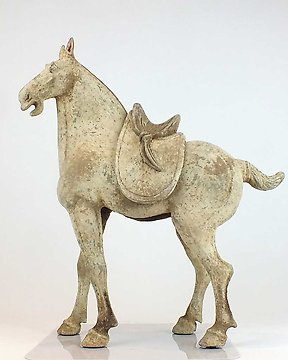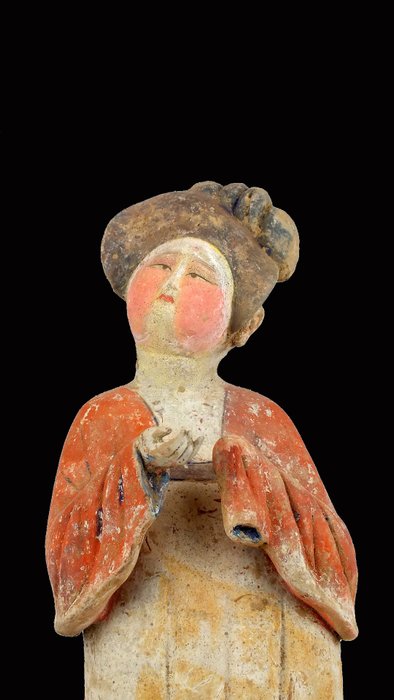
Terracotta, 唐初彩繪灰陶分鞍踏馬圖,TL測試 建築裝飾 - 49 cm
編號 82750095

編號 82750095

China, Tang dynasty, mid-8th century
Height: 48 cm.
Provenance: old Dutch collection.
Note: It will be professionally packed and safely send in a wooden crate within 3 working days by FedEx. Shipped with Insurance!
a painted pottery figure of a court lady, the elegant figure shown standing gracefully on a shaped base and holds both hands in front of her. Her left hand is hidden inside the sleeve, whilst the fingers of her right hand are revealed. The long heavy robes falling in deep fold to reveal one of her cloud-toed shoes, her full face modelled with delicate features framed by the stiff wings of her coiffure which is drawn up into a large loop worn to one side,
Traces of black, red and white pigment.
Our Guarantee: The above item is guaranteed to be of the time period and condition as described, has been exported legally and is legal to buy and sell under all international lows to cultural patrimony.
- The result of the thermoluminescence test, is consistent with the dating of the item, Tang dynasty. Sampling in 3 different points
- The result of the Pre-dose test is consistent with the dating of the item and the test confirms old firing without any kind of artificial x-ray treatments!
The elegant figure exemplifies the court ladies that became fashionable in the second half of the Tang dynasty. Figures of similar style were excavated from the tomb of Wu Shouzhong, who was buried near the Tang capital, Xi’an, Shaanxi province, in 748 A.D. See the Quest for Eternity, Los Angeles Country Museum, 1987, nos. 83 and 84. Although the models of court ladies made in the early part of the Tang dynasty depict them wearing tight-fitting garments, which accentuated their slender forms, the reign of the Emperor Ming Huang seems to have heralded the growing in popularity of a more generous female form and the adoption of less structured, more flowing robes. This change in style has traditionally been attributed to the influence of the emperor’s adored concubine Yang Guifei, who was reported to have had a rather voluptuous figure. However, excavated figures suggest that the fashion for more voluptuous figures was already coming to prominence by the time that Yang Guifei won the emperor’s admiration.
The figures of this type usually hold their hands in front of them, in order to provide a more graceful arrangement of their sleeves, as can been seen in the present court lady.
- A Certificate of Authenticity from Becker Antiques (specialist in Chinese pottery since 1969, Amsterdam) will accompany the item.
- All items legal to buy/sell under The Netherlands covering cultural patrimony and are guaranteed to be as described or your money back.
Additional Information:
Tang Dynasty
National unification during the Tang dynasty brought about centuries of social stability and economic prosperity. Ceramic art evolved further towards maturity and important kiln centres emerge across the country.
The repertoire of mortuary objects in Tang tombs closely followed those of earlier periods. The majority was still made of pottery clay and came in many forms and styles, which illustrate the evolution and traits of Tang ceramic art. These objects can broadly be divided into five categories namely tomb guardians, guards of honour, attendants, animals, and utilitarian wares.
Tang dynasty tomb figures are pottery figures of people and animals made in the Tang dynasty of China (618–906) as grave goods to be placed in tombs. There was a belief that the figures represented would become available for the service of the deceased in the afterlife. The figures are made of moulded earthenware with colour generally being added, though often not over the whole figure, or in naturalistic places. Where the colouring was in paint it has often not survived, but in many cases, it was in sancai ("three-colour") ceramic glaze, which has generally lasted well.
The figures, called mingqui in Chinese, were most often of servants, soldiers (in male tombs) and attendants such as dancers and musicians, with many no doubt representing courtesans. In burials of people of high rank there may be soldiers and officials as well. The animals are most often horses, but there are surprising numbers of both Bactrian camels and their Central Asian drivers, distinguished by thick beards and hair, and their facial features. The depictions are realistic to a degree unprecedented in Chinese art, and the figures give archaeologists much useful information about life under the Tang. There are also figures of the imaginary monster "earth spirits" and the fearsome human Lokapala (or tian wang), both usually in pairs and acting as tomb guardians to repel attacks by both spirits and humans. Sets of the twelve imaginary beasts of the Chinese Zodiac are also found, usually unglazed.
The most common animals, and the most likely to be large and carefully modelled and decorated, are horses and camels. Both sorts range from animals without harness and saddlery to those with elaborately detailed trappings, and carrying riders or, in the case of camels, heavy loads of goods.
The graceful ladies with plump faces and bodies (so called Fat ladies), the smartly dressed civil officials, the mighty warriors, the horses with saddles and accessories, as well as camels and non - Chinese figurines are all results of the potter’s keen observation and superb virtuosity. They allow us to visualise life in China more than a millennium ago.
Condition: Very good condition. Wear consistent with the age, some loss of color. Please be advised that all ancient Chinese pottery objects had been buried in tombs and are excavated from there. Therefore, they can always have some restorations. Also worth of note is that the item is more than 1200 years old.
Important information.
The seller guarantees that he is entitled to ship this lot.
It will be professionally packed and safely send in a wooden crate by FedEx.
Buyers are responsible for import regulation and restrictions of their own country
#pioneeringwomen
#asiantribalexclusive